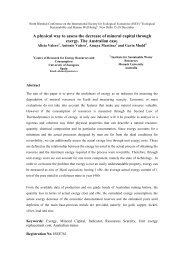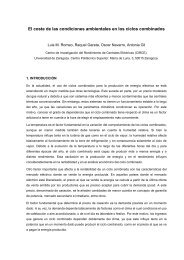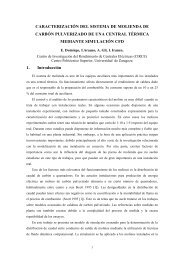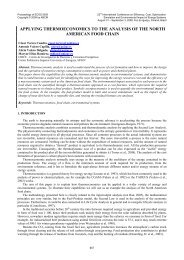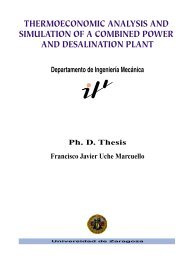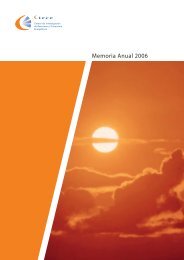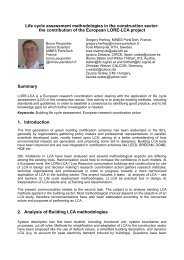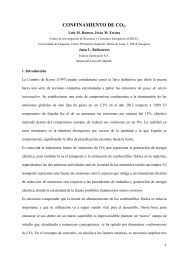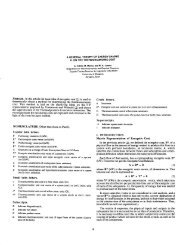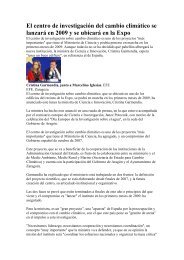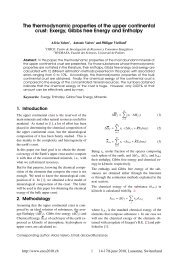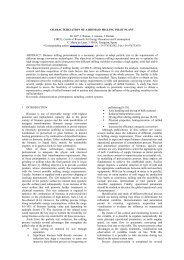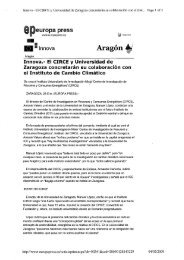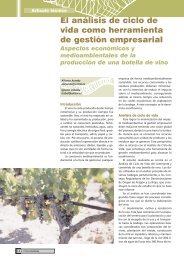Engineering Application of Exergy Analysis - circe - Universidad de ...
Engineering Application of Exergy Analysis - circe - Universidad de ...
Engineering Application of Exergy Analysis - circe - Universidad de ...
Create successful ePaper yourself
Turn your PDF publications into a flip-book with our unique Google optimized e-Paper software.
part <strong>of</strong> the steam can be vented (flow 132,<br />
normally closed).<br />
Liquid water from con<strong>de</strong>nsers and accumulators<br />
(flows 111-113, 121-127) can be pumped and<br />
returned to the drum. Besi<strong>de</strong>s, the drum can be fed<br />
from external fresh water (flow 137), once the<br />
<strong>de</strong>aerator has passed.<br />
2.2. Thermodynamic mo<strong>de</strong>l.<br />
Figure 1shows plant instrumentation used for the<br />
characterization <strong>of</strong> the thermodynamic state <strong>of</strong> the<br />
system: flow rates (M), pressures (P), temperatures<br />
(T) and gas composition (X). The latter refers to<br />
concentration <strong>of</strong> CO, CO2 and O2 in dry basis.<br />
Although they have not been represented in the<br />
figure, levels <strong>of</strong> the four accumulators and position<br />
<strong>of</strong> three-way valve are also available.<br />
2.2.1. Gas flows<br />
To characterize flows 3 to 10, measurements <strong>of</strong><br />
flow rate and dry gas composition are available. In<br />
or<strong>de</strong>r to calculate the amount <strong>of</strong> water, it has been<br />
consi<strong>de</strong>red that gas is dry in flows 3 and 4 and that<br />
is water saturated in flows 5 and 6. In the other<br />
flows, temperature increases slightly and no water<br />
is ad<strong>de</strong>d. Accordingly, it has been consi<strong>de</strong>red that<br />
the flow <strong>of</strong> water is kept constant. Nitrogen<br />
concentration is calculated by difference and, since<br />
it is no reaction, flow <strong>of</strong> CO, CO2, O2 and N2 is<br />
maintained in flows 3 to 8. Depending on the<br />
position <strong>of</strong> the three way valve, flow 8 continues<br />
either in flow 9 or in flow 10.<br />
In or<strong>de</strong>r to calculate flows 1 (converter output) and<br />
2 (external air), a balance to carbon, nitrogen and<br />
oxygen is ma<strong>de</strong>. Besi<strong>de</strong>s, composition <strong>of</strong> 1 is<br />
known (air) and it has been consi<strong>de</strong>red that gas<br />
flow 2 does not contain significant amounts <strong>of</strong><br />
CO2 or O2.<br />
There are temperature measurements in flows 4 to<br />
8 (except in point 7, which has been supposed to<br />
be equal to 6). Temperature <strong>of</strong> flow 2 is equal to<br />
the environment (consi<strong>de</strong>ring that the control<br />
volume is far enough from the hot area around the<br />
converter), and temperature <strong>of</strong> flow 1 is calculated<br />
by energy balance <strong>of</strong> the HRSG.<br />
2.2.2. Water/steam flows<br />
First, there is no measurement <strong>of</strong> the flow <strong>of</strong><br />
saturated liquid leaving the drum towards the<br />
HRSG (flow 101); accordingly, it is fixed by the<br />
<strong>de</strong>sign values. Since flows 131 and 103 are<br />
known, mass accumulated in the drum is<br />
calculated. Due to available measurements in<br />
flows 104 and 135 (and assuming that no steam is<br />
vented), it is possible to calculate flows 105, 106,<br />
107, 133 and 134. Besi<strong>de</strong>s, flows entering the<br />
con<strong>de</strong>nsers are also measured.<br />
In or<strong>de</strong>r to calculate flows corresponding to the<br />
accumulators, rate <strong>of</strong> level variation is used. This<br />
rate can be obtained because evolution <strong>of</strong> all<br />
signals is available. Besi<strong>de</strong>s, it has been supposed<br />
that the amount <strong>of</strong> water leaving all accumulators<br />
is the same. Finally, measurement in 137 allows<br />
one to calculate mass accumulation in the<br />
<strong>de</strong>aerator.<br />
To calculate intensive properties, three pressure<br />
zones have been consi<strong>de</strong>red:<br />
▪ Drum (high pressure): flows 103 to 133<br />
▪ Steam network (medium pressure): flows 134<br />
to 136<br />
▪ Deaerator: flows 137 and 138<br />
Besi<strong>de</strong>s, isentropic efficiency is imposed for<br />
pumps. Finally, an equation is introduced relating<br />
matter and energy accumulation in the drum in<br />
or<strong>de</strong>r to calculate the quality <strong>of</strong> flow 102 (which,<br />
in turn, allows one to calculate the temperature <strong>of</strong><br />
gases leaving the converter by the energy balance<br />
<strong>of</strong> the HRSG).<br />
2.3. <strong>Exergy</strong> analysis.<br />
Once all flows <strong>de</strong>fined in Fig. 1 have been<br />
characterized as <strong>de</strong>scribed in the previous sections,<br />
exergy analysis can be performed [2,3]. <strong>Exergy</strong> <strong>of</strong><br />
a flow i is composed <strong>of</strong> two parts: physical and<br />
chemical:<br />
B = B + B<br />
, (1)<br />
i ph, i ch, i<br />
Physical exergy appears because the flow has<br />
different conditions <strong>of</strong> temperature and/or pressure<br />
that the reference environment:<br />
( ) ( )<br />
B ph, i = fmi⋅⎡hih0, i T0 sis ⎤<br />
⎣<br />
− − ⋅ − 0, i ⎦<br />
, (2)<br />
where fm is the molar rate, h is specific enthalpy<br />
and s is specific entropy. Properties are evaluated<br />
at the conditions <strong>of</strong> flow i and at reference<br />
conditions 0 (but for the same composition <strong>of</strong> flow<br />
i).<br />
Chemical exergy is due to the composition <strong>of</strong> the<br />
flow (different than that <strong>of</strong> the environment):<br />
n<br />
∑<br />
( ln )<br />
B = fm ⋅ x b −R⋅T ⋅ x , (3)<br />
ch, i i i, j ch, j 0 i, j<br />
j=<br />
1<br />
http://www.ecos2010.ch 3 14-17th june 2010, Lausanne, Switzerland



